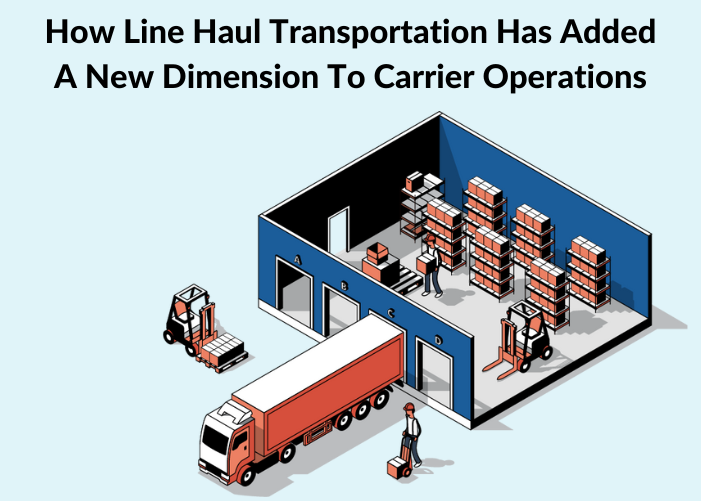Summary
The logistics industry is a complex network of numerous moving parts. This is true, particularly in line-haul transportation, where cargo constantly moves from one location to another through different types of transportation.
By using modern-day technologies and systems, modern-day carriers deploy line haul tracking to ensure the safe and efficient transportation of their cargo.
What does ‘Line Haul Network’ mean?
The movement of goods or freight through various modes of transportation (road, railways, waterways, air) between two locations, for example between two cities, is referred to as ‘Line Haul Logistics’.
As is to be expected, the loads ferried by these various types of transportation aren’t homogenous and vary from small parcels to large, heavy pallets.
CEP providers (i.e. courier, express, and parcel), LTL carriers (less-than-truck-load), and 3PL (3rd party logistics) receive cargo/goods from depots of their customers.
Cargo bound for similar destinations is categorized into long-distance trailers and dispatched to several distribution facilities for further consolidation. At the receiving facilities thereafter, the goods are further sorted based on common elements (type, final destination, etc.) before they leave.
A ‘Line Haul Network’ refers to this entire chain of infrastructure and stakeholders, consisting of hubs, depots, sorting and distribution centers, drivers, and dock workers.
Line-haul carrier: what is it?
It could be successfully argued that carriers play the most important part in line-haul logistics. As already described above, line-haul operations are a complex mix of numerous moving parts. Freight is transferred from one location to another, one warehouse to another, one mode of transportation to another…the list is endless.
Therefore, be sure to choose a line-haul carrier that has expertise and knowledge in managing FTL and LTL loads, fragile cargo, and time-bound deliveries, maintains SLA adherence, and is experienced with regulations and compliances across borders and geographies.
Line-haul carrier tracking: why is it important?
Using digital tools for tracking is a key method of ensuring strong line-haul services. These carrier tracking tools empower both, enterprises and 3PLs, thereby enabling them to maintain real-time visibility of operations. Carrier tracking reduces delivery times, ensures accurate ETAs, and maintains delivery visibility.
Customers know when their package will arrive, thereby significantly improving success rates of first-attempt delivery. Line-haul firms are rapidly adopting modern, artificial-intelligence-driven logistics platforms to optimize cargo movements.
Managers glean critical insights into key areas of carrier operations, including delivery times and success/ failed deliveries, SLA adherence (etc.) to help them in improving performance.
Line-haul carriers: key impact areas
- Delivery times
- Freight movement between cities
- Costs of transportation
- Movement of cargos and goods between locations, depots, sorting facilities, etc.
Line-haul versus Long-haul
Line Haul drivers operate in shifts, not dissimilar to a 9-to-5 job. Therefore, the drivers return home at the end of every workday.
With Long Haul trucking, the drivers are generally out on the road for days and weeks on end.
Line-haul tracking: advantages
Given below are some leading advantages of line-haul tracking.
1. Shorter delivery times: Since the end objective is to ship products as fast as possible while maintaining safety protocols as well as timelines, line-haul transportation is the solution. Provided the company has a panel of trustworthy drivers, tracking achieves safe and on-time shipping to the destination.
2. Improved 3PL management: When outsourcing your operations and freight distribution to 3PL firms, tracking is very useful for both sides. It helps in seamless communication and makes sure that tasks are being carried out per plans.
3. Faster delivery production: The delivery process begins faster since trucks don’t have to wait at one location to be filled to optimum capacity. With carrier tracking, hubs and routes are optimized for the shortest routes and minimal fuel consumption.
4. Lower trucking costs: Tracking is extremely important in maintaining clarity and efficiency about cargo destinations, loads, timings (etc.). The more synergistic the process of receiving-storing-dispatching goods from the warehouse, the lesser the cost of carrying inventory, warehouse costs, and trucking costs (number of trucks, miles covered fully loaded, empty, etc.). When trucks run at optimum capacity, it improves a company’s operating metrics.
5. Improved delivery experience: Tracking ensures that the customer who is due to receive the goods (whether an individual or a company) is prepared to do so. For example, B2B shipments are often massive, heavy, and difficult to load/unload. Tracking helps the receiver be prepared, saves time, and optimizes operations.
Line-haul charge: what is it?
Well, it is quite simply the cost of transportation or the shipping cost. This cost is calculated on the basis of the distance between the pickup point and its destination. Freight loading and unloading aren’t included in the line-haul charges (it applies only to transportation across long distances). Shipping cost is determined by the net weight of the freight.
Naturally, this cost depends on several factors like the type of transportation and the relevant ways of logistics cost calculation. While mileage is used for road transportation, air freight includes line items over and over the freight weight and its mileage.
Line-haul optimization.
All transport companies are under constant pressure to deliver the best services within the shortest timeframes at the most competitive costs.
Line-haul transport optimization is all about enhancing services, coordination, and timely shipping along the hubs and routes from where the trucks collect freight.
Firstly, the hubs are conveniently located along routes that see the most freight traffic. Next, the freight is consolidated based on similar destinations. The freight companies dispatch cargo ranging from light parcels to extremely bulky/ heavy cargo to fragile cargo. Fleet teams and drivers are responsible for the timely transportation of cargo to its destinations.
The following steps help in line-haul optimization:
- Start with a detailed study of the capacity of depots and accounts of the locations.
- Identify the optimal path for cargo movement from start-to-end hubs.
- The insight from these steps then forms the base to optimize a line-haul operation.
Conclusion: Line-haul transportation has created a new dimension to modern-day carrier operations. By using modern automation tools such as last mile delivery software, modern-day carriers are able to provide efficient, safe, and convenient transportation.




